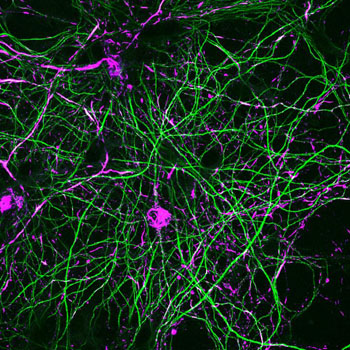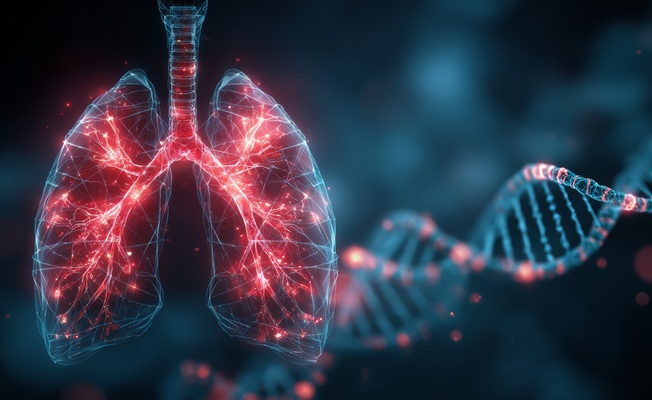Inhibitors of a Mutant Kinase May Be Potential Treatment for Parkinson's Disease
|
By LabMedica International staff writers Posted on 01 Aug 2016 |

Image: Primary hippocampal neurons from mice expressing G2019S-LRRK2. The neurons were treated with alpha-synuclein fibrils, and 18 days later immunofluorescence was performed. The magenta shows phospho-alpha-synuclein inclusions in the cell bodies and throughout the axons, which are visualized as green (Photo courtesy of the University of Alabama).
A potential therapeutic approach for treatment of Parkinson's disease is based on drugs that block the activity of a mutated version of the enzyme LRRK2 (Leucine-rich repeat kinase 2).
The Gly2019S mutation is one of a small number of LRRK2 mutations proven to cause Parkinson's disease. Of these, Gly2019S is the most common in the Western World, accounting for about 2% of all Parkinson's disease cases in North American Caucasians. This mutation is enriched in certain populations, being found in approximately 20% of all Ashkenazi Jewish Parkinson's disease patients and in approximately 40% of all Parkinson's disease patients of North African Berber Arab ancestry.
Pathologic inclusions characterize the class of alpha-synucleinopathies that include Parkinson's disease. However, the interaction between alpha-synuclein, LRRK2, and the formation of alpha-synuclein inclusions remains unclear.
To study these molecular interactions, investigators at the University of Alabama (Birmingham, USA) applied very low concentrations of pre-formed fibrils of alpha-synuclein to in vitro or in vivo neurons. This caused formation of modified alpha-synuclein inclusions that shared morphology with those found in the brains of Parkinson's disease patients after death. The investigators used this model system to test the effects of neuron expression of the mutant G2019S form of the LRRK2 enzyme on the formation of the inclusion pathology.
They reported in the July 13, 2016, issue of the Journal of Neuroscience that G2019S-LRRK2 expression, in both cultured neurons and dopaminergic neurons in the substantia nigra pars compacta region of the rat brain, increased the recruitment of endogenous alpha-synuclein into inclusions in response to alpha-synuclein fibril exposure. Potent LRRK2 kinase inhibitors, which are being developed for clinical use, blocked the increased alpha-synuclein aggregation in G2019S-LRRK2-expressing neurons.
The results obtained during this study demonstrated that alpha-synuclein inclusion formation in neurons could be blocked and that novel therapeutic compounds, which target this process by inhibiting LRRK2 kinase activity, may slow progression of Parkinson's disease-associated pathology.
"These data give us hope for the clinical potential of LRRK2 kinase inhibitors as effective therapies for Parkinson's disease," said first author Dr. Laura A. Volpicelli-Daley, assistant professor of neurology at the University of Alabama. "The LRRK2 kinase inhibitors may inhibit the spread of pathologic alpha-synuclein, not only in patients with LRRK2 mutations, but in all Parkinson's disease patients. Future studies to validate the safety and efficacy of the LRRK2 inhibitors will be necessary before testing the inhibitors in human clinical trials."
Related Links:
University of Alabama
The Gly2019S mutation is one of a small number of LRRK2 mutations proven to cause Parkinson's disease. Of these, Gly2019S is the most common in the Western World, accounting for about 2% of all Parkinson's disease cases in North American Caucasians. This mutation is enriched in certain populations, being found in approximately 20% of all Ashkenazi Jewish Parkinson's disease patients and in approximately 40% of all Parkinson's disease patients of North African Berber Arab ancestry.
Pathologic inclusions characterize the class of alpha-synucleinopathies that include Parkinson's disease. However, the interaction between alpha-synuclein, LRRK2, and the formation of alpha-synuclein inclusions remains unclear.
To study these molecular interactions, investigators at the University of Alabama (Birmingham, USA) applied very low concentrations of pre-formed fibrils of alpha-synuclein to in vitro or in vivo neurons. This caused formation of modified alpha-synuclein inclusions that shared morphology with those found in the brains of Parkinson's disease patients after death. The investigators used this model system to test the effects of neuron expression of the mutant G2019S form of the LRRK2 enzyme on the formation of the inclusion pathology.
They reported in the July 13, 2016, issue of the Journal of Neuroscience that G2019S-LRRK2 expression, in both cultured neurons and dopaminergic neurons in the substantia nigra pars compacta region of the rat brain, increased the recruitment of endogenous alpha-synuclein into inclusions in response to alpha-synuclein fibril exposure. Potent LRRK2 kinase inhibitors, which are being developed for clinical use, blocked the increased alpha-synuclein aggregation in G2019S-LRRK2-expressing neurons.
The results obtained during this study demonstrated that alpha-synuclein inclusion formation in neurons could be blocked and that novel therapeutic compounds, which target this process by inhibiting LRRK2 kinase activity, may slow progression of Parkinson's disease-associated pathology.
"These data give us hope for the clinical potential of LRRK2 kinase inhibitors as effective therapies for Parkinson's disease," said first author Dr. Laura A. Volpicelli-Daley, assistant professor of neurology at the University of Alabama. "The LRRK2 kinase inhibitors may inhibit the spread of pathologic alpha-synuclein, not only in patients with LRRK2 mutations, but in all Parkinson's disease patients. Future studies to validate the safety and efficacy of the LRRK2 inhibitors will be necessary before testing the inhibitors in human clinical trials."
Related Links:
University of Alabama
Latest BioResearch News
- Genome Analysis Predicts Likelihood of Neurodisability in Oxygen-Deprived Newborns
- Gene Panel Predicts Disease Progession for Patients with B-cell Lymphoma
- New Method Simplifies Preparation of Tumor Genomic DNA Libraries
- New Tool Developed for Diagnosis of Chronic HBV Infection
- Panel of Genetic Loci Accurately Predicts Risk of Developing Gout
- Disrupted TGFB Signaling Linked to Increased Cancer-Related Bacteria
- Gene Fusion Protein Proposed as Prostate Cancer Biomarker
- NIV Test to Diagnose and Monitor Vascular Complications in Diabetes
- Semen Exosome MicroRNA Proves Biomarker for Prostate Cancer
- Genetic Loci Link Plasma Lipid Levels to CVD Risk
- Newly Identified Gene Network Aids in Early Diagnosis of Autism Spectrum Disorder
- Link Confirmed between Living in Poverty and Developing Diseases
- Genomic Study Identifies Kidney Disease Loci in Type I Diabetes Patients
- Liquid Biopsy More Effective for Analyzing Tumor Drug Resistance Mutations
- New Liquid Biopsy Assay Reveals Host-Pathogen Interactions
- Method Developed for Enriching Trophoblast Population in Samples
Channels
Clinical Chemistry
view channel
Blood Test Could Predict and Identify Early Relapses in Myeloma Patients
Multiple myeloma is an incurable cancer of the bone marrow, and while many patients now live for more than a decade after diagnosis, a significant proportion relapse much earlier with poor outcomes.... Read more
Compact Raman Imaging System Detects Subtle Tumor Signals
Accurate cancer diagnosis often depends on labor-intensive tissue staining and expert pathological review, which can delay results and limit access to rapid screening. These conventional methods also make... Read moreMolecular Diagnostics
view channel
Genetic Testing Identifies CHIP Patients at Increased Heart Disease Risk After Cancer Treatment
Genetic testing in cancer care often reveals unexpected findings that are not directly related to the tumor itself. One such finding is clonal hematopoiesis of indeterminate potential, a condition caused... Read more
Advances in Liquid Biopsies Improve Detection of Lung Cancer Mutations
Lung cancer remains one of the deadliest cancers, largely because diagnosis often occurs at an advanced stage when treatment options are limited. In non-small cell lung cancer (NSCLC), identifying genetic... Read moreHematology
view channel
MRD Tests Could Predict Survival in Leukemia Patients
Acute myeloid leukemia is an aggressive blood cancer that disrupts normal blood cell production and often relapses even after intensive treatment. Clinicians currently lack early, reliable markers to predict... Read more
Platelet Activity Blood Test in Middle Age Could Identify Early Alzheimer’s Risk
Early detection of Alzheimer’s disease remains one of the biggest unmet needs in neurology, particularly because the biological changes underlying the disorder begin decades before memory symptoms appear.... Read more
Microvesicles Measurement Could Detect Vascular Injury in Sickle Cell Disease Patients
Assessing disease severity in sickle cell disease (SCD) remains challenging, especially when trying to predict hemolysis, vascular injury, and risk of complications such as vaso-occlusive crises.... Read more
ADLM’s New Coagulation Testing Guidance to Improve Care for Patients on Blood Thinners
Direct oral anticoagulants (DOACs) are one of the most common types of blood thinners. Patients take them to prevent a host of complications that could arise from blood clotting, including stroke, deep... Read moreImmunology
view channel
Ultrasensitive Liquid Biopsy Demonstrates Efficacy in Predicting Immunotherapy Response
Immunotherapy has transformed cancer treatment, but only a small proportion of patients experience lasting benefit, with response rates often remaining between 10% and 20%. Clinicians currently lack reliable... Read more
Blood Test Could Identify Colon Cancer Patients to Benefit from NSAIDs
Colon cancer remains a major cause of cancer-related illness, with many patients facing relapse even after surgery and chemotherapy. Up to 40% of people with stage III disease experience recurrence, highlighting... Read moreMicrobiology
view channel
New Test Measures How Effectively Antibiotics Kill Bacteria
Antibiotics are typically evaluated by how well they inhibit bacterial growth in laboratory tests, but growth inhibition does not always mean the bacteria are actually killed. Some pathogens can survive... Read more
New Antimicrobial Stewardship Standards for TB Care to Optimize Diagnostics
Antibiotic resistance is rising worldwide, threatening the effectiveness of treatments for major infectious diseases, including tuberculosis (TB). Resistance to key TB drugs, such as bedaquiline, is of... Read morePathology
view channel
AI-Powered Label-Free Optical Imaging Accurately Identifies Thyroid Cancer During Surgery
Thyroid cancer is the most common endocrine cancer, and its rising detection rates have increased the number of patients undergoing surgery. During tumor removal, surgeons often face uncertainty in distinguishing... Read more
Deep Learning–Based Method Improves Cancer Diagnosis
Identifying vascular invasion is critical for determining how aggressive a cancer is, yet doing so reliably can be difficult using standard pathology workflows. Conventional methods require multiple chemical... Read more
ADLM Updates Expert Guidance on Urine Drug Testing for Patients in Emergency Departments
Urine drug testing plays a critical role in the emergency department, particularly for patients presenting with suspected overdose or altered mental status. Accurate and timely results can directly influence... Read moreTechnology
view channel
AI-Generated Sensors Open New Paths for Early Cancer Detection
Cancers are far easier to treat when detected early, yet many tumors remain invisible until they are advanced or have recurred after surgery. Early-stage disease often produces signals that are too weak... Read more
Pioneering Blood Test Detects Lung Cancer Using Infrared Imaging
Detecting cancer early and tracking how it responds to treatment remains a major challenge, particularly when cancer cells are present in extremely low numbers in the bloodstream. Circulating tumor cells... Read moreIndustry
view channel
WHX Labs Dubai to Gather Global Experts in Antimicrobial Resistance at Inaugural AMR Leaders’ Summit
World Health Expo (WHX) Labs in Dubai (formerly Medlab Middle East), which will be held at Dubai World Trade Centre from 10-13 February, will address the growing global threat of antimicrobial resistance... Read more






















